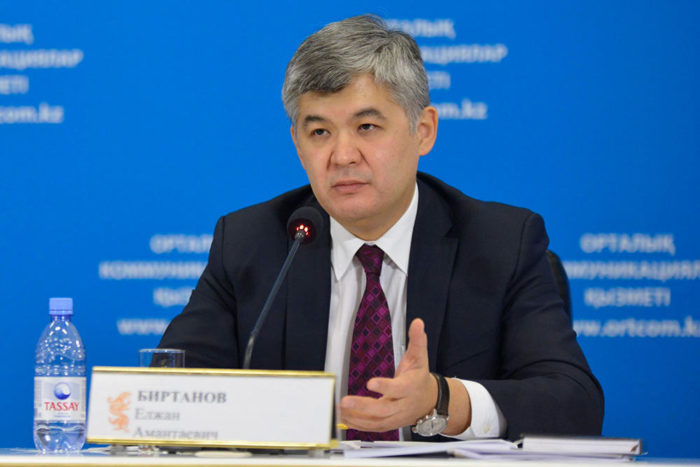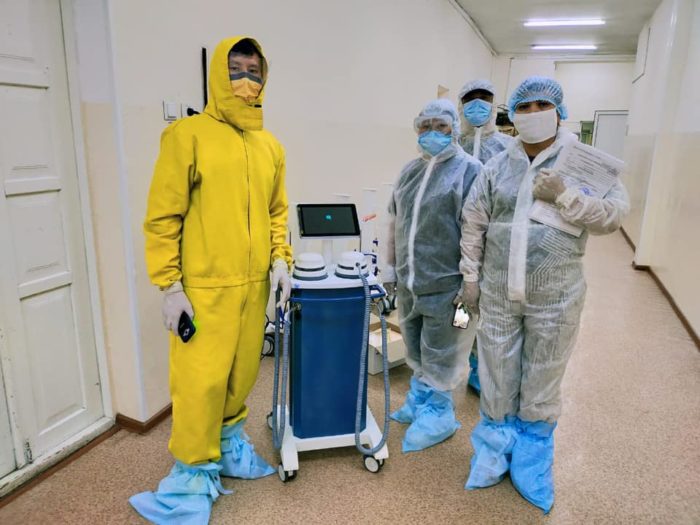Easing restrictions does not mean letting people return to their normal lives, people should “learn to live while in a pandemic, in lockdown, said Kazakh Minister of Healthcare Yelzhan Birtanov during the June 4 online briefing. Earlier this day, Kazakh President Kassym-Jomart Tokayev took to Twitter to call for people to observe lockdown measures including maintaining physical distance, sanitizing items, and wearing face masks in order to prevent the spread of COVID-19.

Kazakh Minister of Healthcare Yelzhan Birtanov
Birtanov noted that a return to a strict lockdown is not yet an option in the fight against coronavirus, but that it is still necessary to take preventive measures and follow the government’s anti-Corona advice. A strict lockdown can be reintroduced if the situation becomes critical again. All enterprises, small and medium-sized businesses, and public transport that resumed its operations should follow strict anti-epidemic measures.
“The experts from the World Health Organization (WHO) for Central Europe predict a potential second wave of coronavirus. We observed the first wave in the second half of April, then there was a decline in Kazakhstan. The second virus wave hit in the middle of May. But the experts suggest a second wave around the world in the fall due to the seasonal epidemic of influenza and viral infections in October,” said Birtanov.
Birtanov said that the ministry does not exclude this risk period in addition to traditional viral agents. To avoid this, the ministry plans to strengthen the public health infrastructure, construct new hospitals and expand the production of personal protective equipment.
The Kazakh government approved the action plan to strengthen medical services, primarily sanitary services and the medical anti-infection service and to expand hospitals and quarantine centers.

Recently the Ministry of Healthcare purchased 87 vibro-acoustic devices for treatment of lung pathology as preventive measures against disease complications.
“Today we are going to reduce the number of active quarantine centers. Many hotels, where the quarantine centers were based, have resumed their operations. Infectious disease hospitals have seen no extra load. We coped with this wave well, despite it being a dangerous epidemic, and, unfortunately, we still see a high mortality rate in other countries. A worst-case scenario cannot be excluded. We need to be ready for any scenarios. We need to prepare for the fall outbreak,” he said.
According to the minister, more than 13,000 patients have confirmed COVID-19 infections and 77 percent of these have mild asymptomatic forms. Currently, 5,836 patients are under treatment and 59 of these have severe forms. A grand total of 61 patients have died from Covid-19 in all of Kazakhstan.
Asymptomatic patients pose a great risk and the ministry’s main task is to identify these patients in a timely manner, then observe and start treatment, if necessary.
Kazakhstan ended the state of emergency on May 11, which was introduced all the way back on March 16. However, lockdown measures remain in place nationwide. Since June 1, the checkpoints were taken down and limited movement between regions was reopened.
As the government faces down concerns of a second wave of infections, WHO Regional Director for Europe Hans Kluge confirmed their fears on June 3rd when he spoke about the potential threat of a second wave “as more and more countries relax restrictions.” He advised that countries instead “transition towards ‘a new normal’ where governments are permanently on the watch for COVID-19, and guided by global health principles, together with economic and societal considerations.”
Some countries in European observed a stabilization or decline in new cases while some countries saw more cases.
Earlier, Kluge spoke highly about Kazakhstan’s early response to the virus outbreak. Careful mass surveillance of the population, extensive testing, private data collection, proactive prevention measures, contact tracing investigations, proper treatment of patients and financial support for vaccine research were all praised by the WHO director.
WHO continues to develop its technical guidelines based on the most up-to-date evidence and trains health workers on how to deal with COVID-19 in 27 different languages.
WHO Director-General Tedros Adhanom reaffirmed WHO’s commitment to work through its regional and country offices “to monitor the pandemic, to support countries and to provide guidelines for every situation” at the media briefing on COVID-19 on June 3rd.


